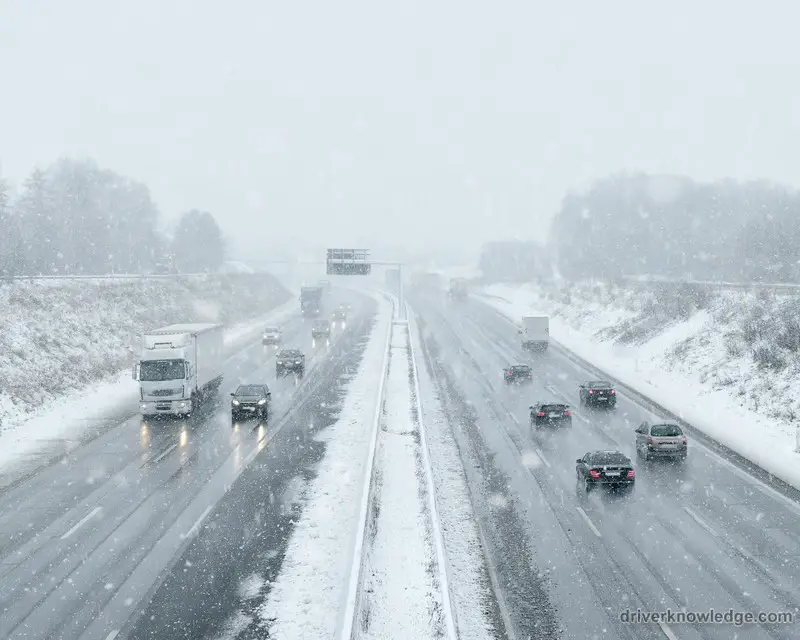The beauty of winter is spellbinding. The fresh snow covering every surface creates a surreal ambience. Unfortunately, this snow cover also makes the roads dangerous for driving. That’s why there are so many tips for winter driving to keep drivers and pedestrians safe.
Here are answers to the questions you may have on safe winter driving.
- How to prepare my car for safe winter driving?
Since the roads in winter get covered with snow, ice and sleet, it becomes a challenge to maneuver on them. It is necessary to ensure your car is working optimally to minimize the chances of accidents and other unappealing scenarios. Make sure you do the following to prepare your car for winter driving:
- Recharge or replace the car battery if it is weak.
- Get a professional to check the ignition for cracks in distributor caps and damaged wires.
- Ensure all lights – taillights, side lights, headlights, brake lights, directional lights, parking lights and emergency flashers – are working properly.
- Make sure the brake pads and brake fluid are alright and your brakes are working the way they should.
- Tire care is extremely important for winter driving. Change to snow tires if you live in a place with heavy snowfall or press the button for all-season radial tires if the snowfall is light.
- Check the pressure in tires before heading out, as for every 9 degree drop in the temperature, the pressure in your tire will reduce by 1 psi.
- Get the tires aligned and balanced before onset of winter.
- Inspect the exhaust system for leaks. Make sure it is sealed properly to prevent carbon monoxide poisoning.
- Always keep the exhaust pipe snow-free to prevent carbon monoxide being forced back inside the car.
- Check the heating system of your car to ensure it is working properly.
- Make sure the antifreeze you use is formulated for the coldest weather.
- Check the front and back defrosters to ensure they are working properly.
- Before going out, make sure your tank is filled. Never let your fuel level drop low, as in snow and wintry conditions, it takes longer to drive. The last thing you need is getting stuck without fuel and no source of keeping yourself warm.
- Make sure the washer container has enough antifreeze and the wipers work efficiently. Replace the wipers if they are worn out or old. Visibility is important during winter driving.

- Do I need a winter driving kit?
Never venture out without a winter driving kit. This kit could be the difference between surviving and dying if you end up in an emergency. The kit should have the following:
- Blanket
- Flashlight
- Snow shovels
- Traction mats
- Flares and emergency lights
- Bag of salt or sand
- Roll of paper towels
- Ice scraper
- Fuel line de-icer
- Extra clothing – warm footwear, windproof pants, gloves, hat, sweater, long Johns, coat, socks, and anything else you can think of
- Booster cables
- Road maps
- First aid kit
- Matches and emergency candles
- How do I prepare myself for winter driving?
When driving in winter, it is important you prepare yourself to prevent mishaps and accidents. Make sure you get reports on road condition before heading out and always plan your driving. Avoid driving if you are tired. Before driving, warm up the car and wear warm clothing.
You can always remove it if you feel too warm. Just make sure you stop at a safe place to remove your clothing. Always carry your mobile phone with you. So make sure it is properly charged. Never leave your phone in the car, as the cold conditions will cause the battery to freeze.
- How should I drive in the winter?
Here are a few tips to ensure you have a safe winter driving experience.
- Always wear your seat belt.
- Drive slowly, as the surface may be covered with black ice, making the road look shiny new.
- Never use cruise control while driving. In wintry conditions, you should ensure you have full control over your car.
- Use low-beam headlights while driving. This also switches on your tail lights, making your car more visible from the rear.
- Stay far from the vehicle in front of you as the stopping time lengthens in wintry conditions. So this distance will account for it.
- If the weather is gradually worsening, look to get off the road before you get stranded.
- Be patient and overtake other vehicles only when you think it is safe.
- Use smooth movements to drive, as jerky driving can cause you to skid.
- What should I do if my car begins skidding?
If your car skids, don’t panic. Do not brake or accelerate. Instead, steer the car in the direction you want to go in. If you are driving a car with automatic transmission, put it in neutral. For manual transmission cars, declutch.
Winter driving is all about being prepared and careful. So, use these tips to drive safely this winter and enjoy the beauty of the season.
